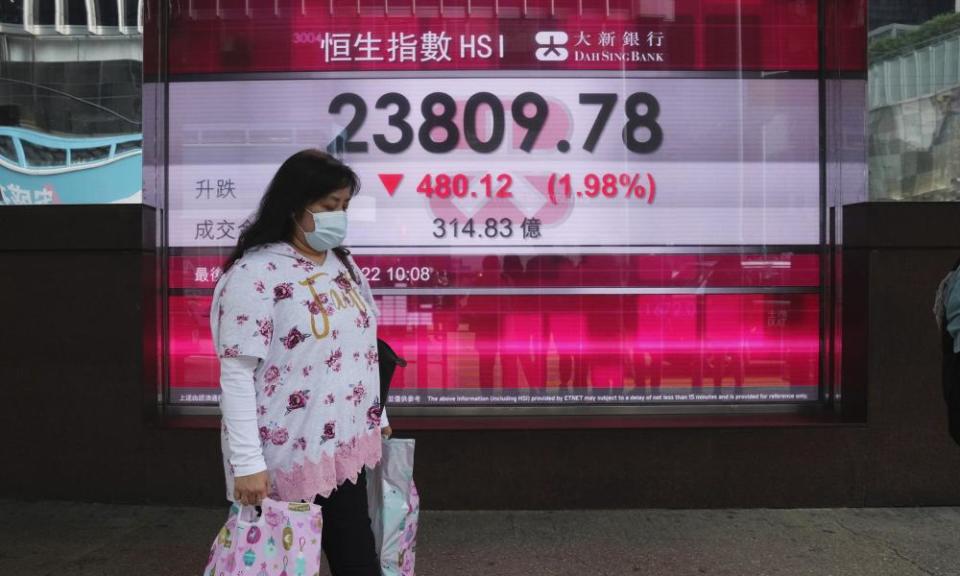‘From market’s best friend to enemy’: Asian shares plunge as US Fed nails on rate rise

Markets in Japan and Korea lose more than 3% on fears of costlier borrowing, with FTSE and Wall Street on course to follow suit
Stock markets in Asia have tumbled to their lowest in nearly 15 months after America’s central bank chief confirmed widely expected plans to tackle higher inflation with an increase in interest rates this year, beginning in March.
With investors also concerned about political tensions between Russia and Ukraine, supply chain problems and rising oil prices, the prospect of sustained increases in the cost of borrowing by the world’s most powerful economy sent a spasm of anxiety through financial markets on Thursday.
“The Fed’s gone from being the market’s best friend, to a possible enemy,” said Kyle Rodda, analyst at the online trading platform IG in Sydney, adding that the Fed wasset on “bringing inflation down, rather than protecting asset prices”.
Related: Highest US inflation in 40 years signals end of ultra-cheap money
The Nikkei in Japan led the way as it closed down more than 3% while the Kospi in Seoul found itself losing 3.5% of its value in a turbulent session. The market in Hong Kong finished off by 2.42% and Sydney shed nearly 2% to enter a technical correction. after shedding 10% from its most recent high.
MSCI’s broad gauge of regional markets outside Japan fell 2.7% to its lowest level since November 2020.
The drop echoed a sharp reversal in US shares on Wednesday. The S&P 500 closed 0.14% lower and the Nasdaq Composite finished barely higher, erasing a rise of more than 3.4%. The Dow Jones average slipped 0.38%.
Markets messier than that friend with a kebab at 3am.
US futures -1%
5-30 curve flattens further
Korea poised for bear market
Australia poised for correction
Asia FX down
We're just a few hours removed from Fed briefing so let's give this time to settle, hopefully. pic.twitter.com/5vxqKFBaUp— David Ingles (@DavidInglesTV) January 27, 2022
The FTSE100 is set to fall nearly 2% when it opens on Thursday morning, according to futures trade, with the Wall Street markets also heading for a hefty loss.
Mike Kelly, head of global multi-asset at PineBridge Investments in the US, said it was a sign to “get the heck out” of US stocks. “It’s all about selling longer duration assets,” he said, “so we are underexposed to US equities.”
In its latest policy update on Wednesday, the US Federal Reserve chairman, Jerome Powell, indicated the central bank was likely to raise interest rates in March, and reaffirmed plans to end its Covid-emergency bond purchases that month before launching a significant reduction in its asset holdings.
US Futures, kinda getting used to red. $TSLA, $QQQ, $SPY pic.twitter.com/4bNe2FbpZR
— ali.tech ⚡️🔋🚀👩🚀🛰 (@elite_investing) January 27, 2022
But in the follow-up press conference, Powell warned that inflation – which has hit levels not seen for decades – remains above the Fed’s long-run goal and supply chain issues may be more persistent than previously thought.
“There was a marked shift in terms of a relatively dovish statement and then a relatively hawkish press conference,” said David Chao, global market strategist, Asia Pacific at Invesco.
“Powell is not committing to the size or the frequency of rate hikes and also the timing of the balance sheet reduction. I think that buys him a bit of wriggle room as to how quickly and with what velocity he wants to normalise monetary policy in the US.”
Chao said, however, that any further rise in inflation in the US, which is now running at 7%, could lead to “a more aggressive monetary policy tightening” meaning more US rate hikes.
If you like red, you're in luck!
Asian equities tracked #WallStreet lower, European and US futures open down#indices #FOMC #Fed pic.twitter.com/vhuO67gShD— Matt Simpson (@cLeverEdge) January 27, 2022
A tougher stance by the Fed is expected to see other central banks drop into line or continue to increase rates, such as in the Bank of England’s case, which increased borrowing costs in December to curb rising consumer prices. The central bank in South Korea has already hiked rates three times in six months
“With the somewhat hawkish signals by the Fed … there may be greater pressure for central banks to act on curbing inflationary pressures as well,” wrote Yeap Jun Rong, market strategist at IG. Earlier this week, Singapore’s central bank surprised markets by tightening its monetary policy settings in its first out-of-cycle move in seven years.
The US dollar rose on Thursday on the back of higher US bond yields, lifting the dollar index – which measures the greenback against major peers – to 96.604, near five-week highs. The pound slipped to $1.343.
The global benchmark Brent crude fell 0.64% on profit-taking to $89.38 per barrel.

 Yahoo Movies
Yahoo Movies 